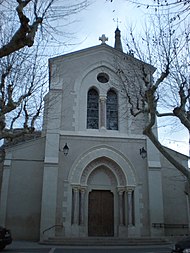Olonzac
|
Olonzac Lonzac |
||
|---|---|---|

|
|
|
| region | Occitania | |
| Department | Herault | |
| Arrondissement | Beziers | |
| Canton | Saint-Pons-de-Thomières | |
| Community association | Minervois Saint-Ponais Orb-Jaur | |
| Coordinates | 43 ° 17 ′ N , 2 ° 44 ′ E | |
| height | 29-182 m | |
| surface | 18.95 km 2 | |
| Residents | 1,770 (January 1, 2017) | |
| Population density | 93 inhabitants / km 2 | |
| Post Code | 34210 | |
| INSEE code | 34189 | |
| Website | Olonzac | |
 Olonzac Town Hall |
||
Olonzac ( Occitan : Lonzac ) is a place and a municipality in the south of France with 1,770 inhabitants (as of January 1, 2017) in the Hérault department in the Occitania region . The municipality belongs to the arrondissement of Béziers and the canton of Saint-Pons-de-Thomières (until 2015: canton of Olonzac ). The inhabitants are called Olonzaguais .
location
Olonzac lies at an altitude of almost 50 m above sea level. d. M. in the landscape of the Minervois and the wine-growing region of the same name . The distance to Narbonne is about 30 kilometers (driving distance) in a south-easterly direction; Béziers is about 43 kilometers east of Narbonne and Carcassonne about 37 kilometers southwest. The Ognon and the Canal du Midi , which also cross here, flow through the municipality .
Population development
| year | 1800 | 1851 | 1901 | 1954 | 1999 | 2017 |
| Residents | 896 | 1603 | 2296 | 2017 | 1568 | 1770 |
The population decline in the 20th century is mainly due to the phylloxera crisis in viticulture and the increasing mechanization of agriculture .
economy
The place and its surroundings were dominated by agriculture for centuries; most people lived on a self-sufficient basis . In the village itself, craftsmen and small traders settled, who also lived on orders from the hamlets and farmsteads in the area. In the early 19th century, viticulture was promoted, the economic importance of which - after the phylloxera crisis in the late 19th century - has grown. Since the 1960s tourism has played a not insignificant role in the economic life of the municipality in the form of renting out holiday homes ( gîtes ).
history
A Celtic settlement ( oppidum ) was uncovered in the hamlet of Bassanel . The oldest mention of the place name Olentiacim comes from the year 852: in 1095 the first landlord of Olonzac known by name is mentioned as a companion of the Count of Minerve. In the early 13th century, the place was involved in the Albigensian Crusades (1209-1229) without being affected itself. Only after the reconquest of Carcassonne by Raimund Trencavel (1224-1226) was the landlord ( seigneur ) of Olonzac, Frottard d'Olonzac , suspected of being a heretic and was murdered. In 1318 the place came from the Diocese of Narbonne to the Diocese of Saint-Pons-de Thomières . 1348 was the year of the great plague epidemic in Europe. In 1355 Edward of Woodstock , the "Black Prince" made a foray into the region, but again Olonzac was not affected. Even in the Huguenot Wars (1562–1598), the fortified place protected by a royal garrison, which was even the seat of the bishops of Saint-Pons-de-Thomières for a time, was spared from destruction. The place developed into an economic center in the region, which was reinforced by the construction of the Canal du Midi in the 17th century. In the 19th century the too small medieval church Notre-Dame was torn down and replaced by a new building; A market hall was built on the site of the Romanesque church of Saint-Jean-du-Puy .
Attractions
- The three-aisled parish church of Notre-Dame-de-l'Assomption is a building from the late 19th century in a neo-Romanesque - neo-Gothic mixed style.
- The interior of Café Plana , which dates from 1862, has largely been preserved in its original form and has been recognized as a monument historique since 1984 .
- In the small Musée archéologique d'Olonzac , finds from the Celtic oppidum and from several dolmens in the area are shown.
- outside
- In the place of the Celtic oppidum of Bassanel there is not much left to see; however, the site was recognized as a Monument historique in 1978 . The finds are exhibited in the local museum.
- The locks and bridges at the junction of the Canal du Midi with the Ognon River have also been recognized as a monument historique since 1998 .
Web links
- Olonzac - photos + short information (French)
- Olonzac, history - photos + information (French)
- Olonzac, Museum - Photos + Info (French)
Individual evidence
- ↑ Olonzac - Viticulture
- ↑ Café Plana, Olonzac in the Base Mérimée of the French Ministry of Culture (French)
- ↑ Oppidum de Bassanel, Olonzac in the Base Mérimée of the French Ministry of Culture (French)
- ↑ Canal du Midi: ouvrages sur la rivière Ognon, Olonzac in the Base Mérimée of the French Ministry of Culture (French)

